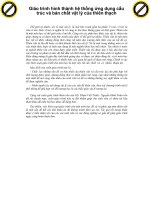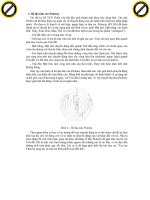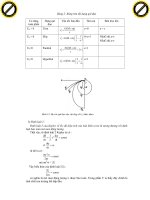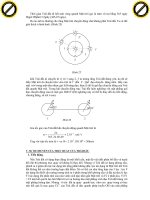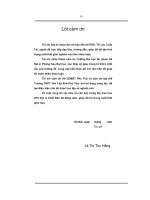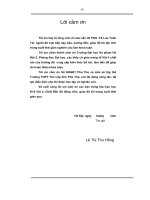CẤU TRÚC VÀ TÍNH CHẤT TỪ CỦA VẬT LIỆU GỐM ĐA TINH THỂ Bi0.84La0.16Fe0.98Ti0.02O3
Bạn đang xem bản rút gọn của tài liệu. Xem và tải ngay bản đầy đủ của tài liệu tại đây (391.62 KB, 5 trang )
<span class='text_page_counter'>(1)</span><div class='page_container' data-page=1>
<b>CRYSTAL STRUCTURES AND MAGNETIC PROPERTIES OF </b>
<b>Bi</b>
<b>0.84</b><b>La</b>
<b>0.16</b><b>Fe</b>
<b>0.98</b><b>Ti</b>
<b>0.02</b><b>O</b>
<b>3</b><b> POLYCRYSTALLINE CERAMIC </b>
<b>Chu Thi Anh Xuan, Pham Truong Tho, Nguyen Van Dang* </b>
<i>University of Sciences - TNU</i>
ABSTRACT
Sample Bi0.84La0.16Fe0.98Ti0.02O3 was prepared by the solid-state reaction method. The analysis of
<i>XRD pattern indicated the coexistence of multi-phase crystal structure of the R3c rhombohedral </i>
<i>and the Imma orthorhombic. The Rietveld refinement method was used to calculate the lattice </i>
parameter, bonding angle Fe–O–Fe, and bonding length Fe–O. Sample showed a typical of weak
ferromagnetic. The presence of multi-phase crystal structure affected strongly the magnetic
properties of sample. Especially, the vertical hysteresis shift (exchange bias) was observed in
sample. We believed that the origin of this effect come from the magnetic interaction at phase
boundary of two crystal structures.
<i><b>Keywords: BiFeO</b>3, Crystal structures, Magnetic properties; multiferroics materials; multiphase </i>
<i>crystal</i>
INTRODUCTION*
Recently, multiferroic BiFeO3 (BFO) has
attracted much attention because of the
coexistence of both ferroelectric and magnetic
properties at room temperature, making BFO
become a potential candidate for many
applications in magnetoelectric devices. Bulk
BFO materials have a rhombohedrallly
distorted perovskite structure (space group
<i>R3c) with a high ferroelectric Currie </i>
temperature <i>(T</i>C 1100 K) and
antiferromagnetic (AFM) Néel temperature
<i>(T</i>N 643 K) [1]. The magnetic order in BFO
<i>is G-type AFM with a cycloid-type spatial </i>
spin modulation. The cycloidal spin spirals
with periodicity of ~62 nm risen from the
combination of exchange and spin-orbit
interactions produces spin canting away from
perfect AFM ordering [2]. In addition, due to
<i>the lack of inversion symmetry in the R3c </i>
structure, BFO shows weak ferromagnetic
(wFM) order associated with
Dzyaloshinky-Moriya (DM) interactions [3]. A disadvantage
of BFO is the existence of a high leakage
current due to impurity phases (such as
Bi2Fe4O9, Bi25FeO40) and oxygen vacancies
generated during the synthesis process. The
improvement of this disadvantage can be
*
<i>Tel: 0983 009975; Email: </i>
based on the partial substitution of Bi by a
rare-earth or alkaline-earth element.
For the case of La-doped BFO, the structural
change and distortion depend on La
concentration that could significantly
suppress impurity phases, reduce oxygen
vacancies. This breaks spiral spin structure,
and lower leakage current. Additionally, FM
order would emerge in the AFM phase. It has
also been found that the crystal structure of
La-doped BFO is strongly dependent on
synthesis and processing conditions. Using
sol-gel method to prepare Bi1-yLayFeO3, one
found cubic and orthorhombic structures in
<i>the samples with y = 0.2 – 0.4 and x = 0.5, </i>
respectively [4]. The tetragonal structure was
reported on Bi0.8La0.2FeO3 prepared by solid
state reaction and sol-gel methods [5,6].
Particularly, a phase separation was found in
Bi1-yLayFeO3<i> as y = 0.16 [7], resulting in </i>
</div>
<span class='text_page_counter'>(2)</span><div class='page_container' data-page=2>
However, no detailed study on the influence
of the crystal structure on magnetic properties
of (La, Ti) co-doped BFO materials,
particularly around the
rhombohedral-orthorhombic phase transfor-mation. Dealing
with this issue, we prepared polycrystalline
Bi0.84La0.16Fe0.98Ti0.02O3 samp-les, and studied
their crystal structures and magnetic
properties by using an X-ray diffractometer,
and a magnetometer. The results obtained
from above measurements indicated the
presence of phase separation between
rhombohedral-orthorhombic crystal structures
and a weak ferromagnetic due to the
structural transformation and doping effect.
EXPERIMENTAL DETAILS
Polycrystalline sample of Bi0.84La0.16
-Fe0.98Ti0.02O3 (BLFTO) was prepared by
solid-state reaction, using high-purity oxides
of Bi2O3, La2O3, Fe2O3 and TiO2 as
precursors. These powders in stoichiometric
masses were thoroughly mixed by using an
agate mortar and pestle, and then pressed into
disc-shaped pellets. After several times of
calcining, the pellet was finally annealed at
900 oC for 20 h. The crystal structure was
studied by using an X-ray diffractometer
<i>(Miniflex Rigaku) equipped with a Cu-K</i>
radiation ( = 1.5405Å). Magnetization
measurements were performed on a vibrating
sample magneto-meter (VSM). All the
investigations were carried out at room
temperature.
RESULTS AND DISCUSSION
The Rietveld refinement of XRD data was
performed using GSAS-II program. A
<i>multi-phase models of R3c rhombohedral and </i>
another crystallographic symmetry such as
<i>Pbam orthorhombic, Imma orthorhombic, or </i>
<i>I4/mcm tetragonal were carried out. Base on </i>
the weighted profile residual (Rwp) and
good-ness of fit (G.O.F), the best fit was obtained
<i>with the R3c + Imma models as shown in </i>
Figure 1. The structural parameters obtained
with the help of the refinement are listed in
<i>Table 1. The R3c phase has lattice parameters </i>
of a = b = 5.573 Å, c = 13.812 Å, which is in
agreement with the JCPDS card No. 86-1518.
<i><b>Fig. 1. Rietveld refined XRD pattern using two </b></i>
<i>phases model of R3c and Imma. </i>
<i><b>Table.1. Refined structural parameter </b></i>
<b>Space group </b> <i><b>R3c </b></i>
<b>(52%) </b>
<i><b>Imma </b></i>
<b>(48%) </b>
<i>a (Å) </i> 5.573 5.633
b (Å) 5.573 7.821
c (Å) 13.812 5.640
Cell volume (Å3) 371.51 248.47
<i>Fe-O-Fe (degree) </i> 149.3 156.8
<i><dFe-O>(Å) </i> 2.053 2.020
<i><dBi-O>(Å) </i> 2.445 2.441
<i>Rwp (%) </i> 4.4
1.06
<i>G.O.F </i>
<i>The Imma phase has lattice parameters of a = </i>
5.633 Å, b = 7.821 Å, and c = 5.640 Å. The
value of Fe – O bond length in octahedron is
approximately equal to 2 Å. And, the Fe – O
– Fe differs from 1800
of the ideal perovskite
structure, which is implication the distorted
R3c symmetry. The partially distorted crystal
structure may affect the magnetic properties
due to the suppression of cycloidal spin
structure. To further confirmed Rietveld
results, we plotted the simulated patterns of
<i>R3c and Imma phase with experimental XRD </i>
pattern, as seen in Fig. 2. It is clear that two
<i>phases model of R3c and Imma phases were </i>
fitted well with the experimental pattern. Our
results are consisted with previous reported
on Bi1-yLayFeO3<i> that the Imma occurred at y = </i>
0.25 [8]. The presence of small among of Ti
In
ten
sit
y
(a
rb
.
u
n
it
</div>
<span class='text_page_counter'>(3)</span><div class='page_container' data-page=3>
(~2 wt%) in Bi0.84La0.16FeO3 can stabilize
<i>Imma phase. The collinear spin structure of </i>
<i>Imma orthorhombic have been studied by </i>
neutron diffraction on Bi0.8La0.2Fe0.8Mn0.2O3
compound [9]. The presence of multiphase
crystal structure was showed a novel effect
such as the double hysteresis loop, unusual
piezoelectric properties, and the exchange
<i>bias effect. Therefore, the coexistence of R3c </i>
<i>and Imma phases with different spin structure, </i>
and magnetic anisotropy may lead interesting
magnetic properties.
20 30 40 50 60 70
31.5 32.0 32.5
simulated
Si
Si
measured
inte
nsity (
ar
b.u
nits)
2 (degree)
Imma
R3c
measured
simulated
Si
<i><b>Fig. 2. Experimental XRD pattern and the </b></i>
<i>simulated XRD pattern of R3c and Imma phases. </i>
<i>Inset shows the representation of R3c </i>
<i>rhombohedral and Imma orthorhombic structures </i>
Moreover, Figure 3shows the hysteresis loop
of BLFTO sample measured at 300 K with
two cycles hysteresis loop. The hysteresis
loops are showed unsaturated magnetization
at 10 kOe with small remanent magnetization
<i>(Mr</i>) confirmed wFM behavior of sample. The
weak ferromagnetic behavior of BLFTO
sample has origin from the partial suppression
of cycloidal spin structure due to the
<i>structural transformation from R3c to Imma </i>
phase. The opening hysteresis loop with large
<i>Mr</i> value compared with pure BFO confirms
the improvement of magnetic properties by
co-doping La and Ti to BFO. It is interesting
to observe the vertical hysteresis shift in
BLFTO sample. The vertical hysteresis shift
is widely known as the minor loop effect,
which only present after cycling hysteresis
loop at high applied field, or cooling sample
in external field from high to low
temperature [10]. Therefore, the vertical
hysteresis shift observed in BLFTO is
unexpected and cannot come from the minor
loop effect.
-10 -8 -6 -4 -2 0 2 4 6 8 10
-0.10
-0.05
0.00
0.05
0.10
0.15
M (emu/g)
H (kOe)
1st
2nd
<i><b>Fig. 3. The M(H) loops of BLFTO sample </b></i>
<i>measured with two cycles (1st and 2nd) </i>
</div>
<span class='text_page_counter'>(4)</span><div class='page_container' data-page=4>
structure. Depending on the sign of applied
field, the spin pining governs the hysteresis
shift behavior. Performing hysteresis loop at
high applied field may destroy the pinned
spin to reveal a high symmetry of hysteresis
loop, as normally observed in previous
reports [12].
-10 -5 0 5 10
-0.10
-0.05
0.00
0.05
0.10
-1 0 1 2 3
-0.01
0.00
0.01
M (emu/g)
H (kOe)
1st
2nd
3th
4th
M
(
e
m
u
/g
)
H (kOe)
<i><b>Fig. 4. The multi-cycles hysteresis loops of BLFTO </b></i>
<i>sample measured after pre-applied -10 kOe </i>
The spin pinning is the origin of the vertical
hysteresis shift and exchange bias effect
observed in sample. The magnitude of the
exchange bias field can be calculated as HEB =
- (Hc1 + Hc2)/2, where Hc1 and Hc2 are the
negative and positive side fields, respectively.
The exchange bias field, which showed in
Figure 3, decreases from 4.0 kOe to 3.2 kOe,
for the first and second hysteresis loops,
respectively. It worth noting that the strength
of exchange bias field decreases with the
increase of applied field. It also depends on
the magnetic coupling between two phases. It
is implied that the exchange bias effect is
dependent on the phase ratio of two phases.
CONCLUSIONS
We have successfully synthesized a
multiferroic Bi0.84La0.16Fe0.98Ti0.02O3 without
any impurity phase. The crystal structure has
been studied in detail using Rietveld
refinement method revealed the multiphase
rhombohedral and orthorhombic presence in
sample. The coexistence of multiphase crystal
structure plays the important role on the
magnetic properties of sample. The magnetic
properties were improved with co-doped La
and Ti to BiFeO3. The vertical hysteresis shift
and the exchange bias effect were observed in
sample. We proposed that the magnetic
coupling at phase boundary is the origin of
this effect. However, further investigation
with another method is necessary to fully
understand the contribution of phase
boundary to the magnetic properties in this
compound.
<b>Acknowledgments </b>
This work was supported by the ĐH2015
TN06-10 project of Thai Nguyen University.
REFERENCES
1. G. Catalan and J. F. Scott (2009), "Physics and
<i><b>Applications of Bismuth Ferrite", Adv. Mater., 21, </b></i>
pp. 2463-2485.
2. I. Sosnowska, T. P. Neumaier, and E. Steichele
(1982), "Spiral magnetic-ordering in bismuth ferrite",
<i><b>J. Phys. C Solid State Phys., 15, pp. 4835-4846. </b></i>
3. C. Ederer and N. A. Spaldin (2005), "Weak
ferromagnetism and magnetoelectric coupling in
<i><b>bismuth ferrite", Phys. Rev. B, 71, pp. 60401. </b></i>
4. Q. R. Yao, J. Cai, H. Y. Zhou, G. H. Rao, Z. M.
Wang, and J. Q. Deng (2015), "Influence of
La-doping on structure and magnetic behaviors in
BiFeO3<i><b>", J. Alloys Compd., 633, pp.170-173. </b></i>
5. T. Fakhrul, R. Mahbub, N. Chowdhury, Q. D.
M. Khosru, and A. Sharif (2015), “Structural,
dielectric and magnetic properties of
Ta-substituted Bi0.8La0.2FeO3<i> multiferroics”, J. Alloys </i>
<i><b>Compd., 622, pp. 471-476. </b></i>
6. Y. Li, H. J. Yang, W. G. Yang, Z. L. Hou, J. B. Li,
H. B. Jin, J. Yuan, and M. S. Cao (2013), “Structure,
ferromagnetism and microwave absorption
properties of La substituted BiFeO3 nanoparticles”,
<i><b>Mater. Lett., 111, pp.130-133. </b></i>
7. D. V. Karpinsky, I. O. Troyanchuk, O. S.
Mantytskaja, G. M. Chobot, V. V. Sikolenko, V.
Efimov, and M. Tovar (2014), “Magnetic and
piezoelectric properties of the Bi<i>1 −x</i>La<i>x</i>FeO3 system
near the transition from the polar to antipolar phase”,
<i><b>Phys. Solid State, 56, pp. 701-706. </b></i>
</div>
<span class='text_page_counter'>(5)</span><div class='page_container' data-page=5>
transformations and magnetic properties of Bi1–
<i>x</i>Ln<i>x</i> FeO3<i> (Ln = La, Nd, Eu) multiferroics”, Phys. </i>
<i>Status Solidi, 246, pp.1901-1907.</i>
9. J. Bertinshaw, D. L. Cortie, Z. X. Cheng, M.
Avdeev, A. J. Studer, F. Klose, C. Ulrich, and X.
L. Wang (2014), “Spin-cycloid instability as the
origin of weak ferromagnetism in the disordered
perovskite Bi0.8La0.2Fe0.5Mn0.5O3<i>”, Phys. Rev. B., </i>
89, pp.144422.
10. E. Fertman, S. Dolya, V. Desnenko, L. A.
Pozhar, M. Kajňaková, and A. Feher (2014),
“Exchange bias in phase-segregated
Nd2/3Ca1/3MnO3 as a function of temperature and
<i><b>cooling magnetic fields”, J. Appl. Phys., 115, pp. </b></i>
203906.
11. M. A. Basith, A. Billah, M. A. Jalil, N.
Yesmin, M. Alam, E. Khan, S. M. E. Hoque, S.
Shafayet, S. Hossain, S. H. Firoz, and B. Ahmmad
(2017), “The 10% Gd and Ti co-doped BiFeO3: A
<i>promising multiferroic material”, J. Alloys </i>
<i><b>Compd., 694, pp. 792-799. </b></i>
12. P. Kumar, C. Panda, and M. Kar (2015),
“Effect of rhombohedral to orthorhombic
transition on magnetic and dielectric properties of
La and Ti co-substituted BiFeO3<i>”, Smart Mater. </i>
<i><b>Struct., 24, pp.045028. </b></i>
TÓM TẮT
<b>CẤU TRÚC VÀ TÍNH CHẤT TỪ CỦA VẬT LIỆU GỐM ĐA TINH THỂ </b>
<b>Bi0.84La0.16Fe0.98Ti0.02O3 </b>
<b>Chu Thị Anh Xuân, Phạm Trường Thọ, Nguyễn Văn Đăng*</b>
<i>Trường Đại học Khoa học – ĐH Thái Nguyên </i>
Vật liệu đa pha điện từ Bi0.84La0.16Fe0.98Ti0.02O3 được chế tạo bằng phương pháp phản ứng pha rắn.
Kết quả phân tích giản đồ nhiễu xạ tia X cho thấy vật liệu đồng tồn tại hai pha cấu trúc
<i>là R3c rhombohedral và Imma orthorhombic. Phương pháp phân tích cấu trúc Rietveld được sử </i>
dụng để xác định các tham số cấu trúc như hằng số mạng, góc liên kết Fe – O – Fe, và độ dài liên
kết Fe – O. Kết quả đo đường cong từ trễ cho thấy vật liệu có tính chất sắt từ yếu ở nhiệt độ phòng.
Sự đồng tồn tại và cạnh tranh của hai pha cấu trúc ảnh hưởng mạnh lên tính chất từ của vật liệu.
Đặc biệt, chúng tôi quan sát thấy hiện tượng đường cong từ trễ bị dịch theo trục từ độ (hiệu ứng
trao đổi hiệu dịch). Theo chúng tôi, hiệu ứng này có nguồn gốc bởi tương tác từ tại vùng biên pha
cấu trúc.
<i><b>Từ khóa: BiFeO</b>3, Cấu trúc tinh thể, Tính chất từ, Vật liệu đa pha điện từ; đa pha cấu trúc.</i>
<i><b>Ngày nhận bài: 25/8/2017; Ngày phản biện: 13/9/2017; Ngày duyệt đăng: 30/9/2017 </b></i>
*
</div>
<!--links-->
